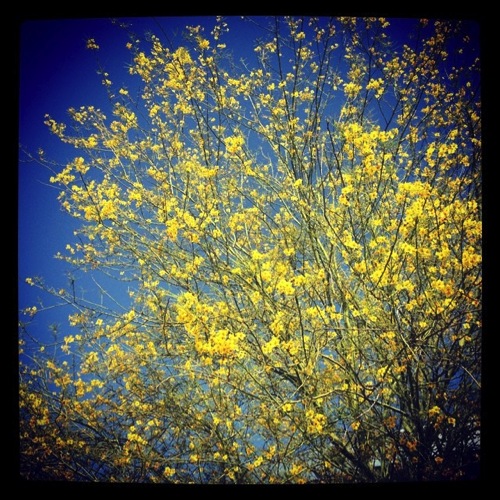Palo Verde Tree (Parkinsonia florida)
Although we don’t see a lot of Parkinsonia here in the San Fernando Valley, it is widely used in our nearby desert communities like Palm Springs. My sister has several in her garden. They are a nice looking tree and fairly well-behaved in their growing habit. The trees are especially beautiful when they are in bloom, like this one I found on my walk yesterday.
Photo: Douglas E. Welch
Parkinsonia florida, the Blue Palo Verde (syn. Cercidium floridum), is a species of palo verde native to the Sonoran Deserts in the Southwestern United States and Northwestern Mexico.[1] [2]Its name means “green pole or stick” in Spanish, referring to the green trunk and branches, that perform photosynthesis.
This plant is primarily found in the Sonoran Colorado Desert of southeastern California, and the Sonoran Deserts of southern Arizona and of northwestern Sonora state (Mexico). It is found predominantly in desert washes or bajadas, a result of its need for water, although occasionally it can be found in creosote desert scrub habitat, accessing seeps in desert hills up to 3,600 feet (1,100 m). [3][4] Also found in the far eastern Mojave Desert of California in the ‘upper’ Lower Colorado River Valley, and occasionally in the Mojave’s mountains. [2][3]
Parkinsonia florida grows to heights of 10–12 metres (33–39 ft). It is a rapidly growing large shrub or small tree, and rarely survives to 100 years. Compared to the closely related Parkinsonia microphylla (foothill paloverde), it appears more decumbent in overall form, is taller, and matures more quickly.
The plant’s trunk, branches, and leaves are blue-green in color, hence the common name. The plant is drought-deciduous, shedding its foliage for most of the year, leafing out after rainfall.Photosynthesis is performed by the blue-green branches and twigs, regardless of absent leaves. [5]
The flowers are bright yellow, and pea-like, which cover the tree in late spring. They attract pollinators such as bees, beetles, and flies. They are followed by seed pods which are slightly larger and flatter and have harder shells than the foothill paloverde. These are a food source for small rodents and birds. [5] — Wikipedia
- Palo Verde Tree (Parkinsonia florida) at Wikipedia
- Palo Verde Tree (Parkinsonia florida) at Desert USA
- Palo Verde Tree (Parkinsonia florida) at Arizona Native Plant Society
Previously in the Interesting Plant series:
- Espalier Fruit Trees
- California Poppy (Eschscholzia californica)
- Hydrangea ‘Zorro’
- Harlequin flower (Sparaxis tricolor)
- Erythronium
- Sempervivum
- Primula auricula
- Feathery Cassia (Senna auricula)
- Red Stick Dogwood (Cornus alba ‘Sibirica’)
- Japanese Maple (Acer palmatum)
- Kousa Dogwood (Cornus kousa)
- Giant Chalk Dudleya (Dudleya brittonii)
- Sunrose (Helianthemum nummularium)
- Australian/New Zealand Tea Tree (Leptospermum scoparium)
- Brugmansia Sanguinea
- Calico Monkeyflower (Mimulus pictus)
- Colocasia Esculenta
- Acer palmatum ‘Sango-kaku’ (Coral Bark Japanese Maple)
- Linderniaceae (formerly Torenia) Kuaui Deep Blue
- Passiflora (Passion flower)
- Firewheel Tree (Stenocarpus sinuatus)
- Anemone
- Allium Cowanii
- Symphyotrichum oblongifolius (Purple Aster)
- Hemerocallis ‘Derrick Cane’ (Daylily)
- Agastache ‘Aztec Rose’
- Rudbeckia hirta Moreno
- Kalanchoe Tomentosa
- Albuca namaquensis
- Hosta ‘Remember Me’
- Dahlia ‘Clair de Lune’
- Lovely silver-tinged fern on campus of Oberlin College, Ohio
- Tricolor Beech (Fagus sylvatica Purpurea Tricolor)
- Climbing Hydrangea (Hydrangea anomala petiolaris)
- Eremurus ‘Lemon Meringue’
- Lupine “Sunrise” (Lupinus hartwegii)
- Chinese Fringe Flower (Loropetalum chinense)
- Streptocarpus ‘Harlequin Blue’
- Nigella damascena (love-in-a-mist, ragged lady)
- Epiphyllum (Orchid Cactus)
- Sempervivum ‘Westerlin’
- Gladiolus ‘Kings Lynn’
- Hosta sieboldiana ‘Dorothy Benedict’
- Begonia “Escargot”
- Asparagus Pea (Psophocarpus tetragonolobus)
- Rosa banksiae (Lady Banks’ Rose)
- Primula ‘Victoriana Silver Laced Black’
- Oxalis versicolor
- Poached Egg Plant (Limnanthes douglasii)
- Parisian Carrots
- Fritillaria imperialis Rubra Maxima
- Clematis “Fascination”
- Swiss Chard “Bright Lights”
- Georgia Rattlesnake Melon
- Dianthus Barbathus “Green Ball” or “Green Trick”
- Coleus “Religious Radish”
- Black Forest Calla Lily
- Black Bamboo
Interesting Plant is a series from A Gardener’s Notebook blog and podcast that highlights the most interesting plants I find in my Internet and real-world travels — Douglas
